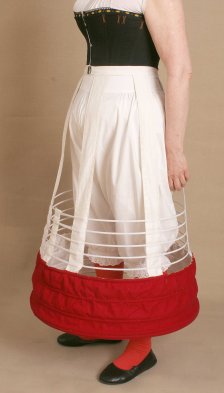
The Crinoline 1856 - 1870
The crinoline, a petticoat of steel hoops, was invented in about 1856. Skirts had been growing in size for a number of years prior to this and various different methods had been used to achieve the fashionable shape.
Layers of petticoats with cording, tucks, quilting and horsehair had failed the Victorian lady in sustaining the increasing size of skirt, and the crinoline frame provided an easy, lightweight solution.
The style of crinoline on the left would have been made in a factory and is about the smallest adult size made, being 2 metres round the hem.
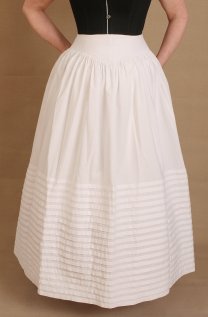 Here the crinoline has been covered with a cotton petticoat, cartridge pleated into a shaped waist yoke and trimmed with 18 rows of tucks. A yoke such as this keeps the fullness of the petticoat away from the waist and adds bulk to the hips so accentuating the bell like shape. If crinolines are not covered with a decent petticoat the ridges of the steels show through and appear very ugly.
Here the crinoline has been covered with a cotton petticoat, cartridge pleated into a shaped waist yoke and trimmed with 18 rows of tucks. A yoke such as this keeps the fullness of the petticoat away from the waist and adds bulk to the hips so accentuating the bell like shape. If crinolines are not covered with a decent petticoat the ridges of the steels show through and appear very ugly.
Only one or two petticoats were needed over a crinoline frame to achieve the fashionable shape and this was hailed as a great saving in cost, both in petticoats and in laundering.
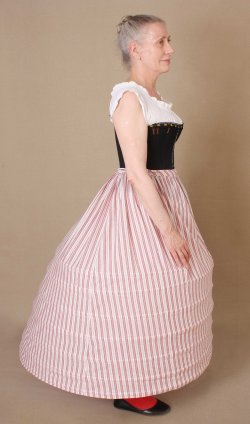 National Trust Crinoline c. 1864
National Trust Crinoline c. 1864
The original of this crinoline is held by the National Trust and has been used to teach school children about Victorian clothing.
The flatter front and backward thrusting shape date it to the mid 1860s when crinolines ceased being round and bell-shaped, with the fullness moving towards the back.
By 1870 all the skirt's fullness became concentrated at the back, developing into the bustle.
Despite the sewing machine becoming common at this time, this crinoline was made entirely by hand.
The 1860s lady who owned the original crinoline had a very large waist - 101.5 cm or 40" after corseting!
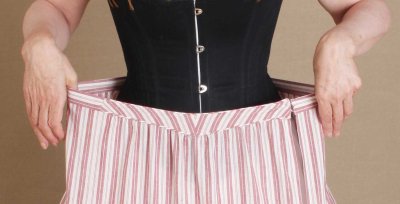
Despite the size of this hoop (2 metres 74 cm hem) it is very light to wear and yet sturdy because of the multiple rows of bones. However it does easily swing as the wearer walks and can flip up to show the drawers if care is not taken to sit correctly in it. From the 1860s petticoats became very decorative with tucks, frills and insertion in case they were seen as the crinoline swayed.
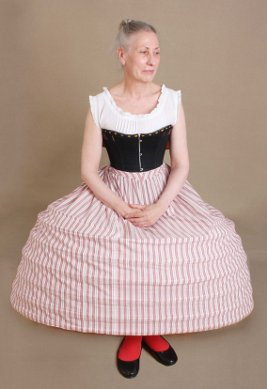
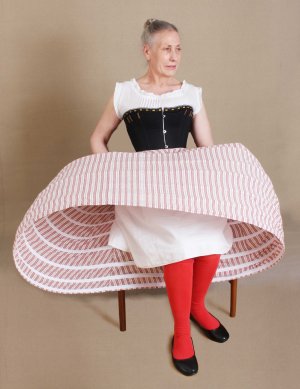
Sitting Correctly
Sitting Incorrectly
After taking a pattern from the original I made a copy to be used for school visits at the property but made one small adjustment. So that the copy could fit a range of wearers for trying on, I left the waist at the original size and added crossed drawstrings into the waistband. I also copied a bustle from the same property and gave both items to the Learning Department so that the originals need no longer be handled.
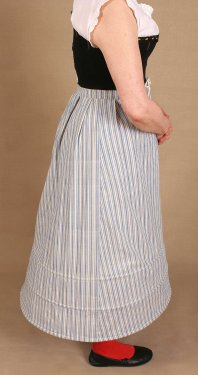
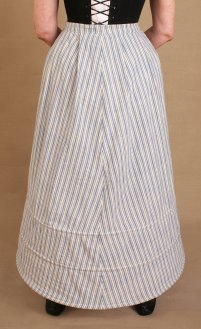 Accession Number: 79.53.935
Accession Number: 79.53.935
Norwich Costume & Textile
Research Centre, Norfolk
This small crinoline dates from the mid to late 1860s when the skirt changes shape from a round to an oval with most of the fullness at the back of the skirt.
I was attracted to this crinoline because of the blue and white striped cotton from which it was made. Finding a similar modern striped fabric was difficult but I hope that my version is as attractive as the original.
It is very simply constructed with four panels of fabric and only three rows of 5 mm narrow steel bones towards the hem. This sort of crinoline could be made at home and many survive like this in museums across England.
The sewing on this crinoline was very good with all the stripes of the fabric neatly chevroned down the gored centre back seam. Victorian home sewing can be very erratic, from exemplary text book style sewing to something that shows little proficiency and just a desire to keep up with the fashions.
Originally 'crinoline' referred to a fabric made of horsehair cloth which when made into a petticoat provided volume for ladies skirts. When the steel frame was first introduced it adopted the term 'crinoline' and so it has come down to us to mean a hooped skirt. In the Victorian age the crinoline could be known by a range of names such as the steel petticoat, the artificial cage crinoline or simply the cage.
